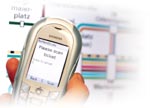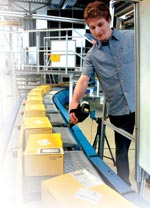|

Siemens |
| |
“The most profound technologies
are those that disappear. They weave themselves into the fabric of everyday
life until they are indistinguishable from it.” Mark Weiser |
 |
| |
ITU’s
report on “The Internet of Things” looks at how ubiquitous technologies
promise a world of interconnected devices. Technological and market aspects
are examined, as well as opportunities for developing countries. A
statistical annex covering over 200 economies is included.The report was
produced by ITU’s Strategy and Policy Unit |
The Internet of Things
Tomorrow’s world is on the way
The daily lives of many people have been revolutionized by the Internet, which
connects us together, irrespective of distance and time zone. Now, according to
a new report from ITU, we are on the brink of a further revolution as, over the
next two decades, the fast growing numbers of people surfing the web are likely
to be overtaken by a huge army of inanimate objects that communicate with each other
online. For example, refrigerators will be able to exchange information with supermarket
shelves, laundry machines with clothing — or the clothes that you are wearing to
“talk” to whatever you are walking past. This connecting of the physical world with
the Internet’s virtual world has been called the “Internet of Things.”
The revolution we can expect is outlined in ITU’s publication “The Internet
of Things,” the seventh in the series of ITU Internet Reports, which
has been specially prepared in time for the second phase of the World Summit
on the Information Society (WSIS) in November 2005. The report explains how a mobile
phone, for example, can be fitted with a unique identifying device that transmits
data about who and where you are, at the same time as it allows you to receive specific information about your
locality. And already, electronic tags, equipped with radio transmitters, are being
put onto manufactured goods that mean each item can be tracked online anywhere,
at any time. Some of these tags are as tiny as a grain of sand; truly, they could
be applied to almost anything.
The infrastructure needed to support the Internet of Things is fast being developed
(Figure 1). Worldwide, more than 2 billion mobile phones were in circulation in
mid-2005. With mobile Internet services and the deployment of higher-speed, next-generation
mobile networks, such as 3G (IMT-2000), users can connect from almost any location.
They can also access networks at any time, through always-on connectivity. Also,
ways are being explored to expand the coding system used to define Internet addresses.
At present, a 32-bit code yields about 4 billion addresses. A code using 128 bits
(such as the “Ucode” being developed by Japan’s Ubiquitous ID Center) would
give us enough addresses for a trillion tags to be assigned to individual objects
every day — for a trillion years.
Our future environment is expected to be filled with invisible networks of tiny
processors, all communicating with each other, unnoticed by us (Figure 2). The late
Mark Weiser, former chief scientist at the XEROX Palo Alto Research Center, California
(United States), described this future in 1991 when he coined the term “ubiquitous
computing.” In his words: “The most profound technologies are those that disappear.
They weave themselves into the fabric of everyday life until they are indistinguishable
from it.”
|
Figure 1 —
Access to the Internet widens
Internet users and subscribers in
the period 1995–2004 (left chart). Top 10 countries by number of 3G subscribers
in 2004 (right chart)

|
Technologies take the lead
The Internet will be expanded to real objects through the application of key
technologies such as radio-frequency identification (RFID), wireless sensing, and
nanotechnology.
Although the Internet of Things is a relatively new vision, its enabling technologies
have been around for some time. RFID was invented in the middle of the 20th century
and materials using nanotechnology have been on the market for over a decade. Combining
technologies like these gives rise to the “smart” items that we hear more and more
about, such as robots, “smart cars” and “intelligent buildings.” Also, advances
in miniaturization mean that smaller and smaller things will have the ability to
connect and interact with the network, and with each other. The ITU report examines
recent advances in nanotechnology that will embody greater processing capabilities
in increasingly tiny packages.
RFID offers the location-specific item identification that is essential for thing-to-thing
communications. It is the most mature of the enabling technologies, with established
standardization protocols and commercial applications already reaching a market
that is growing fast. Revenues from RFID are estimated to have reached between USD
1.5 and 1.8 billion in 2004. Nanotechnology is somewhat less mature, although excitement is building about its prospects. The National
Science Foundation (NSF) in the United States estimates that worldwide annual production
for nanotechnology sectors will reach USD 1 trillion by 2015, with electronics and
semiconductors showing promising signs of growth.
Figure 2 — The Internet of Things
Introducing a new dimension into the communications
environment

|
|
Sensor technologies bridge the gap between the physical and virtual worlds, enabling
objects to respond to changes in their environment. Wireless sensor networks are
already widely used in many situations, such as security gates, environmental monitoring,
and home automation. They will become even more widespread as the cost of making
sensors tumbles. Meanwhile, robotics is expanding beyond its base in the factory,
and the market for domestic robots is expected to be the scene of major growth in
future.
The impact of such technologies — alone and in combination— cannot be underestimated.
It will challenge existing structures within the telecommunication industry, while
forming the basis for entirely new opportunities and business models.
| |

Radio-frequency identification (RFID) technology
reads data on each package and its journey. This makes stock control much
more efficient
Siemens |
Potential new markets
Between 1990 and 2003, the world telecommunication market almost tripled in value
from USD 374 billion to USD 1124 billion, a growth rate of 8.8 per cent (Figure
3). Developing country markets have been growing at almost twice the rate of industrialized
ones, and by 2003, the developing world accounted for one fifth of global telecommunication
revenues. But the most remarkable increase has taken place in mobile communications,
which rose from just 2 per cent of the market, by value, in 1990 to 43 per cent
in 2003. It seems likely that in 2005, for the first time ever, revenues from mobile
services will be greater than those from fixed-line operations.
Broadband access has changed the nature of the Internet, which is already cannibalizing
revenue streams for telephone calls on fixed lines. The arrival of the Internet
of Things will boost this trend even more. Global revenues for data are growing
at a much faster rate than for voice, and this is likely to continue as millions of
objects communicate with each other. So the Internet of Things could provide an
important new market in telecommunications, as communicating devices are embedded
throughout our environment.
Opportunities for the developing world
Developing countries are also innovating and adapting these new technologies,
which have much to offer in helping to achieve development goals. Applications based
on the Internet of Things can bring practical improvements in medical diagnosis
and treatment, for example, as well as cleaner water, improved sanitation, energy
production, increased trade, and better food safety.
One example can be seen in the production and export of commodities, where sensor
technologies are being used to test the quality and purity of items such as coffee,
in Brazil and Chile, and beef in Namibia. RFID has been used to track shipments
of beef to the European Union to verify the origin and handling of each carcass.
This not only ensures quality at a time when trading standards are becoming tougher;
it also helps producers in developing countries to expand their exports.
Nanofilters are in use in Bangladesh to filter water so that it is safe to drink.
Nanosensors could be used to monitor water quality at reduced cost, while nanomembranes
could assist in the treatment of waste water. Elsewhere, emerging technologies could
improve the quality and medical treatment in the developing world, through using
the Internet of Things to monitor the origin of safe drugs and eliminating counterfeits.
Figure 3 — Fast-growing telecommunications
Trends in telecommunication service
revenues between 1990 and 2003 (USD billion), broken down by developed and developing
countries and by fixed-line/mobile services

|
|
Sensor technologies have much to offer regions that are vulnerable to natural
disasters, where extensive and effective warning systems are needed to prevent loss
of life and property. Robots have been used to detect and remove land mines to save
lives and limbs in conflict zones.
In India and China, national initiatives to support research and the creation
of software mean that advances in these technologies may well originate in those
developing giants. The huge research programmes currently being undertaken mean
that the Internet of Things in those countries will be adapted to local conditions
and circumstances. Far from being passive followers, the developing world looks
set to lead in the implementation and widespread adoption of these emerging technologies.
| |

Siemens
Patients at a hospital in New York wear RFID wristbands containing information on their medical histories
and treatments.
This helps hospital staff to provide safer and better care
|
Standardization is needed
Standardization is essential for the mass deployment and diffusion of any technology.
Today’s Internet and mobile phones would not have thrived without standards. As
the Internet of Things becomes reality, standardization protocols will become even
more complex, with almost every computing element and household object having the
potential to be part of a network. Currently, standards remain fragmented among
the relevant, new technologies. To make the Internet of Things a reality, this issue
of standardization must be systematically addressed to ensure the interoperability
of communication protocols.
What privacy?
So, the technical infrastructure for the Internet of Things is being put into
place, and the telecommunications industry views it as a lucrative, new market.
But do consumers really want fridges that automatically order groceries, or vacuum
cleaners that can directly report faults to their makers? Also, because sensors
and smart tags could be used to track peoples’ movements and habits without their
knowledge, profound concerns over privacy and data protection remain widespread.
When monitor screens carry cameras, and doorknobs carry fingerprint sensors, current
concepts of privacy are likely to become outdated. Invisible and constant data exchange
will occur — on a massive scale — between things and people, and between things
and other things, unknown to the “owners” of such data. Who will ultimately control
the data collected by the electronic ears and eyes surrounding us?
Public concerns and active campaigns by consumers have already scuppered commercial
trials of RFID by two well-known retailers. To promote the more widespread adoption
of the technologies underlying the Internet of Things, principles of informed consent,
data confidentiality and security must be safeguarded. Unless there are concerted
efforts to protect these values, involving all government, civil society and private
sector stakeholders, there will be delays in achieving the potential benefits of
a fully-fledged Internet of Things.
|


